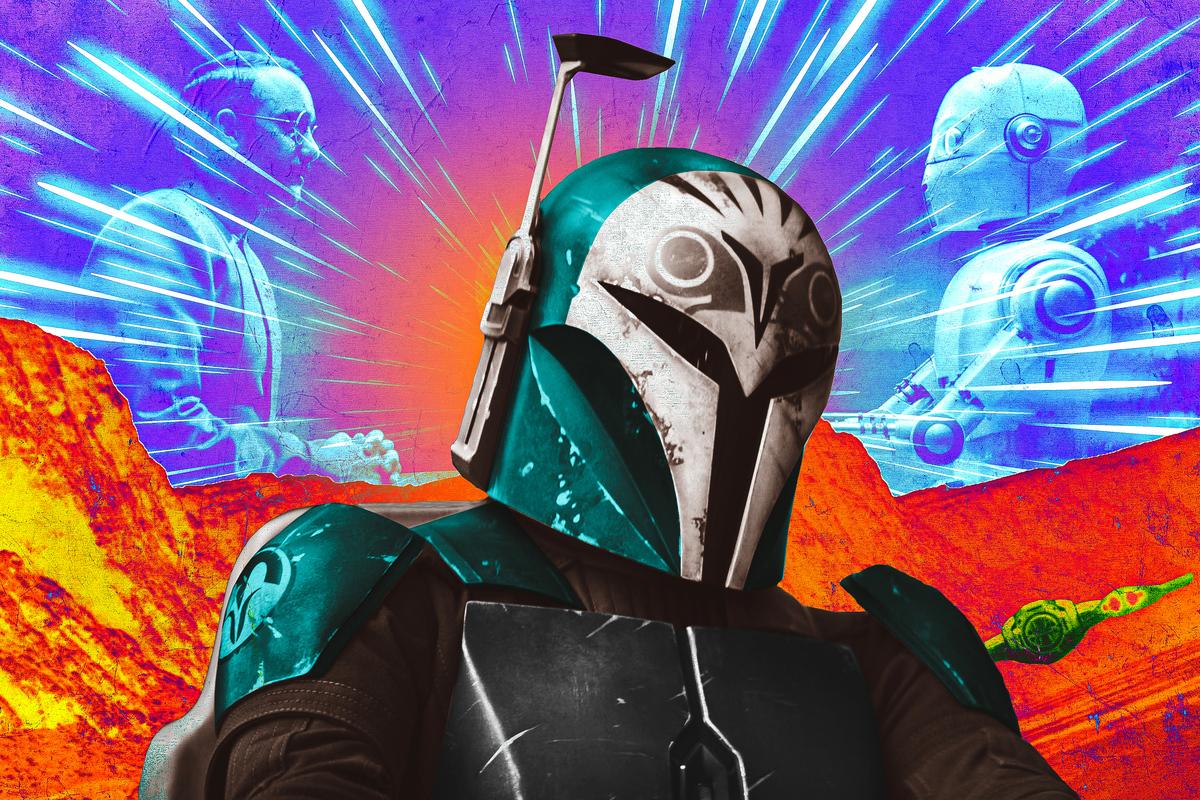The ‘Mandalorian’ Chapter 19 Recap: “The Convert” Flies Into an ‘Andor’-Shaped Shadow
Season 3’s third installment strays from the Outer Rim to the Core Worlds, from core characters to a supporting player, and from lore to politics, taking it out of the Mando sweet spot

When I made it midway through the credits of Chapter 19 of The Mandalorian, “The Convert,” Disney+ tried to entice me to keep streaming. “Because you watched The Mandalorian,” the screen said, as it showed off the first episode of another Star Wars series: Andor. Had I not already watched, rewatched, and recapped Andor, this would’ve been a great recommendation, because “The Convert” was the most Andorian (sorry, wrong franchise) episode of The Mandalorian yet.
Now, I’m not saying that “The Convert” was an Andor homage or imitation. Jon Favreau had been writing Season 3 of The Mandalorian for “a while” as of April 2020 (when it was reported that Tony Gilroy had assumed showrunner duties on Andor), and filming wrapped well before Andor aired. It’s certainly conceivable that Favreau got some sneak peeks at the scripts and the dailies, but it’s also possible that the similarities in setting and subject matter between this episode and Gilroy’s series are a complete coincidence. If so, it’s an unfortunate one for The Mandalorian, because direct, consistent comparisons to Andor do Favreau no favors. You have to hand it to the algorithm, though: Watching Andor right after “The Convert” could bring only relief, in much the same way that a regular bat feels light after you swing a weighted one in the on-deck circle.
“The Convert” is the weighted bat in this analogy in part because it’s pretty ponderous: It’s the longest episode of The Mandalorian to date. Last week, I disputed the idea that the brilliance of Andor makes The Mandalorian any less lovable because the two typically stay out of each other’s way and deliver different delights. This week, though, The Mandalorian encroaches on Andor’s corner, straying from the Outer Rim to the Core Worlds, from core characters to a supporting player, and from massive creatures, legendary blades, and mystical lore to politics, bureaucracy, and spycraft. Swinging weighted lumber right before batting doesn’t seem to help hitters; if anything, it tires them out. “The Convert” isn’t a total whiff, but it may cause fatigue among fans who’ve seen both series. As a friend of mine put it, “If Andor didn’t exist, this episode would make me think, ‘I wish there were a whole show like this.’” There already is, so whatever the cover version’s virtues, it can’t help but fall short in some respects. I appreciate The Mandalorian’s willingness to experiment, but—to extend the strained baseball metaphor—this episode falls just a bit outside its sweet spot.
There are some Mandalorians in this episode of The Mandalorian, and like “The Convert,” we’ll start with them. The episode, which was helmed by Star Wars first-timer Lee Isaac Chung in his first credited work since writing and directing Minari, picks up where “The Mines of Mandalore” left off: with a waterlogged Din Djarin and Bo-Katan Kryze recovering from their unexpected deep dive into the Living Waters. Din is pretty pumped to have fulfilled his latest quest way before the finale—or so we must assume, given that we still can’t see his face and that Pedro Pascal reads a lot of his post-processed lines with the same inflection. As I speculated he would, Din bottles some living water to bring back to the Armorer as proof of his redemption. The primary purpose of the scene, however, is to establish something else that seemed likely last episode: Mando didn’t see the Mythosaur.
“You see anything down there?” Bo asks, super casually. Mando answers, “I saw the chasm passing me as I fell.” One would think that he probably would’ve mentioned the Mythosaur if he’d seen it and felt like sharing, but Bo must know for sure, which leads to this extremely unsuspicious exchange:
Bo: Did you see anything alive?
Din: Alive? Like what?
Bo: Nothing.
Smooth. Somehow, she suppresses the follow-up that must be on the tip of her tongue—“So you definitely didn’t see a Mythosaur, right?” Mando must be too transported by being born again from the sea to pick up on the implication, but it’s clear to us: Bo may have missed out on the Darksaber, but she’s not about to let Din claim the Mythosaur, too. After Bo rescued Din twice last week, kicked cyborg butt with the Darksaber, and didn’t so much as cast a longing look at the blade before surrendering it again, one might have thought that the Bo-Din alliance was strong. But if the beskar-clad frenemies are going to get together—philosophically, militarily, or romantically—they’ll have to hash out the small matter of the Mythosaur first.
Though the scene complicates that duo’s already up-and-down relationship (and makes it clear that the Mythosaur sighting was just one step on a season-long path to anointing a Mandalorian leader), it does explain why there wasn’t a sign about no lifeguard being on duty. The Living Waters, we learn, didn’t always run so deep, but “the bombings from the Purge must have triggered seismic activities.” If those seismic activities caused the Mythosaur to rise up from even farther underground, then the bombings that ended the old age of Mandalore may also have helped herald a new one.
If last week’s action owed a debt to Jedi: Fallen Order, this week’s is straight out of Rogue Squadron, Rogue Leader, or Squadrons. As Bo, Din, and Grogu fly back to Kalevala, Bo’s ship takes a hit, which prompts an astute observation from Mando: “We took a hit!” Our heroes are under attack by TIE interceptors, and though Bo could, in theory, elude them by jumping to hyperspace, Mando recommends that she make for the planet, drop him off in midair, and wait for him to rocket to the N-1 and tag team the TIEs as her wingman. Aside from a flubbed superhero landing, it works, as the two do some fancy flying straight out of Top Gun: Maverick (or, for that matter, Battlestar Galactica) to take out the interceptors. Unfortunately, there are more TIEs where those came from: A trio of bombers do to Castle Kryze what Moff Gideon’s bombers did to Sundari, and then a cloud of interceptors force Bo and Din to punch it out of the Mandalore system. (It’s surprising that the castle hadn’t been bombed before, considering its proximity to Mandalore and Bo’s opposition to the Empire.)
The presence of this swarm of TIEs raises a pressing question that Mando gives voice to: “Where’d they come from?” Bo notes that she’s pissed (sorry, scugged) off Imperial warlords who could be out for revenge, but when the larger squadron of interceptors arrives, she adds, “That’s a lot of ships for an Imperial warlord.” TIE interceptors and bombers don’t have hyperdrives by default, which suggests that these craft came from a nearby capital ship or are based somewhere in the neighborhood. Does that mean that the Empire still maintains a permanent presence in the system, or even on Mandalore itself? When Paz Vizsla later repeats the fake news about Mandalore’s mines and atmosphere, Din retorts, “These are lies meant to keep us in exile.” If so, who’s telling the lies, and why? After the season premiere, I wondered whether “the supposed poison will turn out to be a false rumor spread by the Empire to ward away the natives”—maybe because the Imperial Remnant is still using Mandalore for mining purposes, or maybe because it’s in the Empire’s best interest for its old enemies not to unite. Thus, the attack could be an attempt to prevent Bo and Din from sounding the all clear.
Although we don’t see Bo, Din, and Grogu’s destination until the end of the episode, we might as well skip straight to that scene to tie a bow on the minority share of the episode set aside for Mandalorians. (Remember, it’s called “The Convert,” not “The Covert,” though Bo could be a convert, too.) Bo and Co. were bound for the unnamed, giant-alligator-infested planet where the Armorer and her clanmates are holed up. Much to Vizsla’s surprise, the Living Waters sample proves to be the real deal. Just like that, Din is redeemed—and because Bo took a dip too and hasn’t removed her helmet since, she’s also redeemed. (Not that she ever considered herself an apostate.) One of us!
Bo and Din may be headed for a showdown, as may Bo and the Armorer, but for now, they’re part of one big, happy cult. As little, um, credence as Bo gives to the Creed, the warm welcome she gets from the Children of the Watch makes for quite a contrast to the solitude of her throne room after her former allies ditched her because she failed to reclaim the Darksaber. And that Mythosaur-skull emblem on the wall looks different to her now that she knows that the beast is real. Part of her may just be happy to have a home again after her empty castle was destroyed; she is, after all, a Death Watch and Nite Owl alum. Another part of her must be envisioning showing up at a future clan meeting on Mythosaurback and pulling off a kind of coup. But if she removes her helmet, then they would consider the Mythosaur rider an apostate, which could cause a crisis of faith.
The downside of these developments is that for now, we’re still a ways away from the show’s major Mandalorians embracing a helmet-optional dress code. I don’t know about you, but I’m getting a tad tired of inferring emotion from the angle of a visor. Between Grogu not talking (though he may have tried to babble, “This is the Way”), Din not emoting, and Bo donning her helmet, too, The Mandalorian’s understated depictions of its leads’ inner states leave a lot to the imagination. Considering what the Mandalorians have been through, it makes sense that they’d keep a lid (literally) on their feelings, but from a spectator perspective, bowed helmets and gasps go only so far.
If you’re craving face time, though, “The Convert” has plenty—just not with the face many fans have been hoping to see. “The Convert” is almost an hour of The Mandalorian! (Yay!) That mostly stars Dr. Pershing. (Hmm.) Pershing—Penn Pershing, we now know—last appeared in the Season 2 finale, when he explained the layout of Gideon’s flagship to Din’s ragtag assault team. The semi-conflicted cloner has since been admitted to the New Republic’s Amnesty Program and settled in Coruscant’s Amnesty Housing for reformed Imperials, after passing through the “Re-integration Institute.”
Not only has Pershing’s service to the Empire been forgiven, but he’s also a celebrated public speaker among the upper crust of Coruscant society, where he walks red carpets and regales the glitterati with stories of his research (at the Galaxies Opera House—fittingly, the site of Darth Sidious’s famous speech about unnatural, life-extending abilities). However, while he’s feted in some parts of the galaxy’s capital by socialites who fawn over his expertise and revel in their proximity to someone who once worked for the enemy, he’s dehumanized in others, where he lives in institutional housing and goes by the designation “Amnesty Scientist L52.” By night, Pershing orates about the noble pursuit of knowledge, but by day, he’s (understandably) banned from accumulating the kind of knowledge he seeks. Even as he accepts applause—which is kind of confusing, to be honest, if cloning is considered so taboo—he tugs the ear that was singed by Cara Dune’s blaster bolt, a reminder of the previous life he hasn’t fully left behind.
The Mandalorian hasn’t previously devoted time to Imperials unless they’re hunting or tormenting Mando or Grogu, so “The Convert” represents a significant departure in perspective and tone. Pershing, sympathetically portrayed by Omid Abtahi, is a compelling, if heretofore underutilized, character. He’s no mad-scientist stereotype: True, he had few qualms about drawing Grogu’s blood, but he didn’t want to kill the kid. (Only history’s greatest monsters would want to kill Grogu, but Gideon can’t clear that extremely low bar.) His greatest failing may be the naivete that persuades him that everyone else craves knowledge for noble reasons. Assuming his stated origin story is true—his mother, a doctor, died because simple organ cloning wasn’t available on his world—he may have begun with the best of intentions, but he’s seen enough to know that in the wrong hands, his research is dangerous. Yet the same naivete tempts him to underestimate how complex cloning ethics really are and to resume his work—ostensibly for purehearted, pro-Republic reasons. It also leads to his transparent manipulation by another ex-Gideon lackey, Elia Kane (Katy M. O’Brian).
Aesthetically speaking, “The Convert” leaves a lot to be desired in comparison with the wardrobes, interiors, and location shots of Andor’s seat of Imperial power. The Volume works incredibly well for some settings and set pieces, but the Volume version of Coruscant looks really low rent—and not in the convincingly lived-in sense that, say, Syril’s mom’s bleak dwelling does. I like the live-action look at Umate, the mountain whose peak pokes out of Monument Plaza—the jaunty, canned, diegetic rendition of the “March of the Resistance” is a nice touch, too—but it’s impossible to suspend disbelief about it being a stage in Manhattan Beach. Pershing’s job and office are supposed to evoke the cog-in-a-machine monotony that Syril’s do, but they lack Andor’s off-kilter, Brazil-ian design.
In this season’s sole exception to the pattern of episodes penned by Favreau alone or by Favreau with Dave Filoni, Favreau cowrote the script for “The Convert” with Noah Kloor, a staff writer on The Book of Boba Fett who had previously worked for Favreau’s production company as a coordinator on The Lion King and The Chef Show before joining The Mandalorian’s first season as a writer’s assistant. When The Mandalorian’s scenery is striking and its action is relentless, it’s easy to overlook excessive exposition like last week’s or clunky lines like this week’s “Bring me to my ship and I’ll be on my way. You will forever have my gratitude,” “We took a hit,” or “You have to get out of there. There’s too many of them, we’ve got to get out of here.” Brilliant dialogue isn’t The Mandalorian’s calling card—that’s more Andor’s strong suit—but the awkward diction is more evident when the pace slows down enough to let us sit with lines like “I do miss the lights of hyperspace.” (Another ex-Imperial’s lament about the Empire’s superior uniforms rings true, though.)
“Empire, Rebels, New Republic, I can’t keep track,” one privileged Coruscanti citizen says. “That’s why I should just keep my mouth shut.” (“We try not to get involved,” his wife chimes in.) It’s not exactly subtle compared to, say, Andor’s exchanges between Mon Mothma and Perrin. Plus, we’ve heard this sentiment expressed in this series before: Recall Migs Mayfeld’s monologue about how the Empire and the New Republic are “all the same” to the natives of Morak, or Mando’s and Greef Karga’s dismissive comments about the New Republic. “Not much has changed, other than taking down the cogwheels,” Kane tells Pershing, but it seems like a sign that something has changed that the Republic hasn’t put Pershing, a “top-tier target,” to work on perfecting cloning for the other side, à la ex-Nazis advancing the U.S. space program. It’s also safe to say that Andor wouldn’t undercut a torture scene by having the victim say, “It was a trap,” followed by a Mon Calamari mugging in a reaction shot. It’s as if The Mandalorian was aiming for a somber sequence outside its usual wheelhouse but wound up with an awkward fusion of adult-oriented drama and kid-friendly fan service.
It’s not as if the Rogue One prequel has sole ownership over gritty, grounded, morally gray incarnations of Star Wars, but it’s tough for Favreau to play on Gilroy’s turf, mere months after “One Way Out,” without the result feeling like off-brand Andor. That’s not to say that one series is superior to the other—The Mandalorian does a lot of things well that Andor doesn’t do. It’s just that the timing isn’t kind to “The Convert.” Unless, of course, you haven’t seen Andor, in which case you may be thinking, “I wish there were a whole show like this.” If so, does the Disney+ recommendation screen ever have a hot tip for you!
To its credit, “The Convert” makes it clear that some members of the Amnesty Program have sincerely changed their ways. Kane isn’t one of them. After she entraps Pershing, she sees to it that he’s subjected to the full force of the Mind Flayer (not that one), instead of its more moderate, supposedly therapeutic, Republic-approved “Mitigator” setting. (It seems kind of careless of the Republic to leave the torture knob intact!) This may have been both our first and our last chance to spend an extended interlude with the not-so-good doctor: Perhaps what Pershing knew was too valuable to the Empire for Gideon (who may or may not have already escaped) and his coconspirators to let the New Republic keep him compos mentis. Then again, the future First Order might still desire Pershing’s services, so maybe Kane (who got payback and bolstered her value as a double agent by turning Pershing in) just wanted to zap him enough to make him forget who the bad and good guys are. Either way, Grogu remains in danger, too—and as Season 3 approaches its halfway point, The Mandalorian will also have to tread carefully, lest it risk diluting its more personal story lines with additional detours into possible spin-off setup and the franchise’s series-spanning effort to explain how Palpatine returned.


